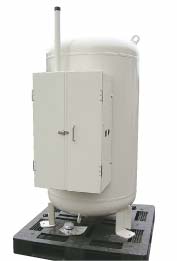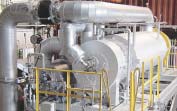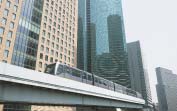Home > About Us > Corporate Social Responsibility > Sustainability Report > Sustainability Report 2006 > Contribution to Environmental Protection through Products, Technologies and Services (4) Reducing the Burden
| Environmental Management Sustainability Report 2006 |
|||
| Contribution to Environmental Protection through Products, Technologies and Services (4) |
| Reducing the Burden on the Environment |
|
 Small, Above-Ground Bulk Gas Vessels |
|||||
| Technology for Cleaning Contaminated Soil | |
| Kobelco Eco-Solutions Co., Ltd. has developed the RH-SP Process for cleaning contaminated soil. The new process is based on the RH (Reduction Heating) Process, which heats the soil to 350 - 550°C in a reduced (non-oxygenated) atmosphere, thus separating and decomposing PCBs, dioxins, organic chlorine-based agricultural chemicals and other toxic substances. The RH-SP Process combines the RH Process with the SP Process, a PCB treatment technology also owned by the company that disperses metallic sodium. Because it generates neither exhaust gas nor wastewater, the RH-SP Process can be used without the risk of secondary contamination. Verification tests earned the technology recognition for its effectiveness from the Ministry of the Environment and the Japan Industrial Waste Technology Center, opening prospects for commercializing the Process. Units are now in production, with orders anticipated for such applications as decontamination of soil and cleaning the bottoms of harbors and rivers. In Okinawa Prefecture, studies are being done on the effective use of decontaminated soil in greening projects. |
 RH-SP Process |
| Start-Up of New Transit Systems | |
| Two new, automated rubber-tired transit systems developed by Kobe Steel started operation in early 2006. The Portliner extension between Kobe Airport and Port Island started service on February 2, followed on March 27 by the start up of the extended Yurikamome Line connecting Ariake Station in Tokyo's Rinkai Fukutoshi district with Toyosu Station on the Yurakucho Line. Kobe Steel has been a pioneer in advanced transit systems in Japan, starting with a business tie-up it formed with The Boeing Company of the United States in 1972. For more than three decades, we have provided comprehensive engineering solutions for various automated systems, including safety signals, automated operation, and schedule management systems. We have also proposed and executed projects overseas including the transit shuttle that began operation in 2003, connecting terminals at the Taiwan Taoyuan International Airport. Kobe Steel's new transit systems are called automated guide-way transit (AGT) systems comprised of an elevated track upon which train cars run on small rubber tires. One of its special features is the fact that it can be completely automated if desired. Because it does not generate CO2 emissions, it is an environmentally friendly transit choice that is effective in easing excessive urban congestion. |
 New Transit Systems |


